Art & Tech
See the Extraordinary First Images From NASA’s Webb Space Telescope, the Most Detailed Pictures Ever Taken of Deep Space
After more than six months, we can finally see Webb's stunning views of the cosmos.
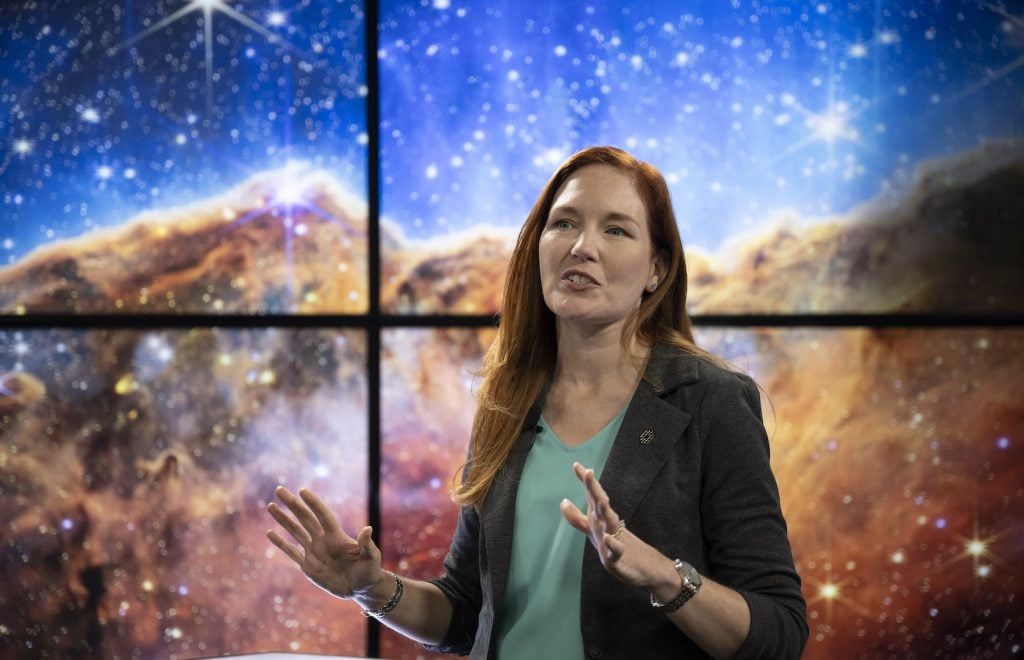
After more than six months, we can finally see Webb's stunning views of the cosmos.

Sarah Cascone

This week, NASA unveiled the first official images recorded by the new James Webb Space Telescope, which stands to take unprecedented images of the universe, allowing us to peer into the farthest reaches of space and the beginnings of time.
Mind-blowing in their beauty, Webb’s glittering landscapes reveal in astonishing detail the Carina Nebula, the Southern Ring Nebula, a galactic cluster known as Stephan’s Quintet, and the galaxy field SMACS 0723, which is home to some of the universe’s oldest galaxies. Webb also took atmospheric readings of a planet dubbed WASP-96b, orbiting a distant star.
The striking images represent “a historic moment for science and technology, for astronomy and space exploration, for America and all of humanity,” president Joe Biden said at a White House press conference on Monday evening unveiling the stunning “Deep Field” image of SMACS 0723.
“If you held a grain of sand on the tip of your finger at arm’s length, that is the part of the universe that you’re seeing, just one little speck of the universe,” NASA administrator Bill Nelson said of the shot.
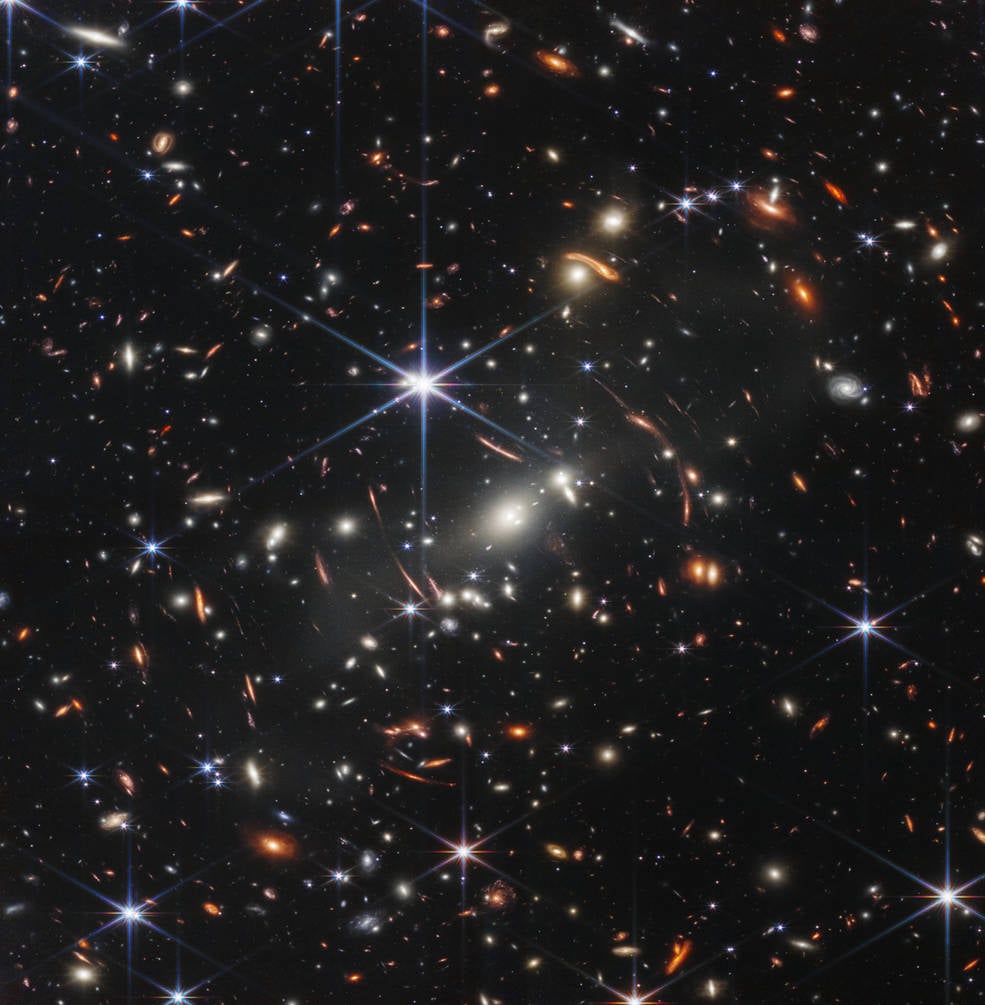
The James Webb Space Telescope’s first image was this “Deep Field” image of galaxies formed over 13 billion years ago. NASA, ESA, CSA, STScI, Webb ERO.
“This is the oldest documented light in the history of the universe from 13 billion—let me say that again, 13 billion—years ago,” Biden added. “It’s hard to even fathom.”
Scientists believe that the Big Bang was some 13.8 billion years ago. The new Webb Deep Field image captures light from an astonishing 13.5 billion years ago, allowing us to see for the first time galaxies formed just a few hundred million years after the birth of the universe.
The edges of the image appear bent due to the cluster’s enormous gravitation field, which functions as a giant lens, magnifying and distorting light otherwise too distant to detect.
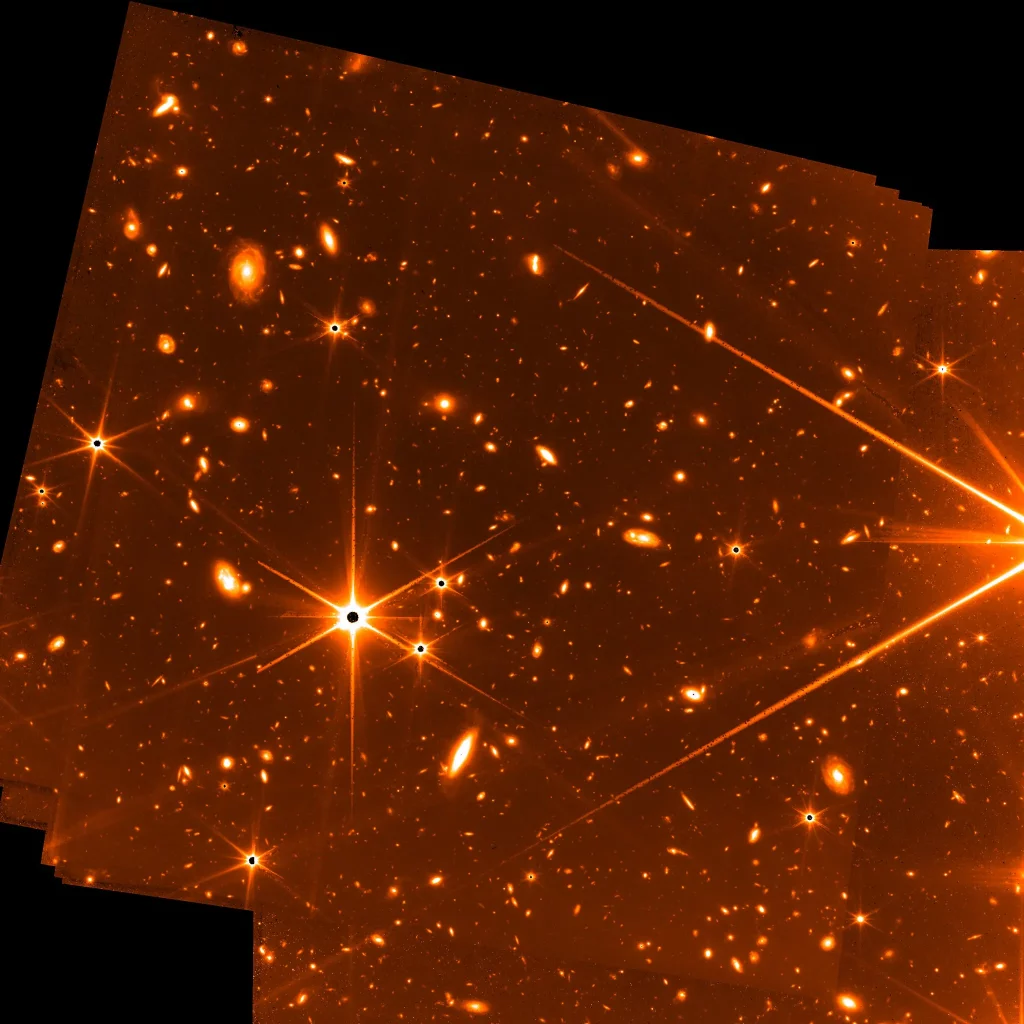
A Fine Guidance Sensor test image from the James Webb Space Telescope released in May. Courtesy of NASA, CSA, and FGS team.
The Hubble Space Telescope, in operation since 1990, previously imaged the same region of the universe in its famous Hubble Ultra-Deep Field image in 2004, but it was only able to detect light from as far back as 13 billion years ago.
As the world’s most powerful telescope, Webb was able to reveal the faintest objects humanity has ever been able to detect in infrared light in its image—and it’s just getting started.
To get a sense of just how much further Webb sees than Hubble, check out this GIF shared by the European Space Agency on Twitter comparing the two Deep Field images. The new image reveals star clusters and other faint structures where there was only blackness—and while Hubble needed weeks to make its Deep Field observations, Webb took just 12.5 hours to capture its far more detailed view in much higher resolution.
Step into the #Webb time-machine and journey back to within a billion years after the Big Bang with these deep views of the Universe.
Explore more here ? https://t.co/lpwKl4bg6L #WebbSeesFarther #EuropeMeetsWebb #ExploreFarther pic.twitter.com/ZixdR2TQuB
— ESA (@esa) July 12, 2022
NASA followed up the Deep Field unveiling with the release of four additional Webb observations today, at an event at the Goddard Space Flight Center in Greenbelt, Maryland. A committee with members from NASA, the European Space Agency, the Canadian Space Agency, and the Space Telescope Science Institute in Baltimore worked together to decide what Webb would observe first.
“We ended up with about 70 targets, from which we had to select only a handful—what would create the most beautiful images, what would highlight the instruments,” Klaus Pontoppidan, Webb project scientist, said in a video played during the unveiling.
“When we saw the first data come down of real targets, people were speechless,” he added. “Immediately we could see how incredible this observatory would be—the detail, the sharpness, the the depth. And when we saw the first color images, we knew that we had a winner.”
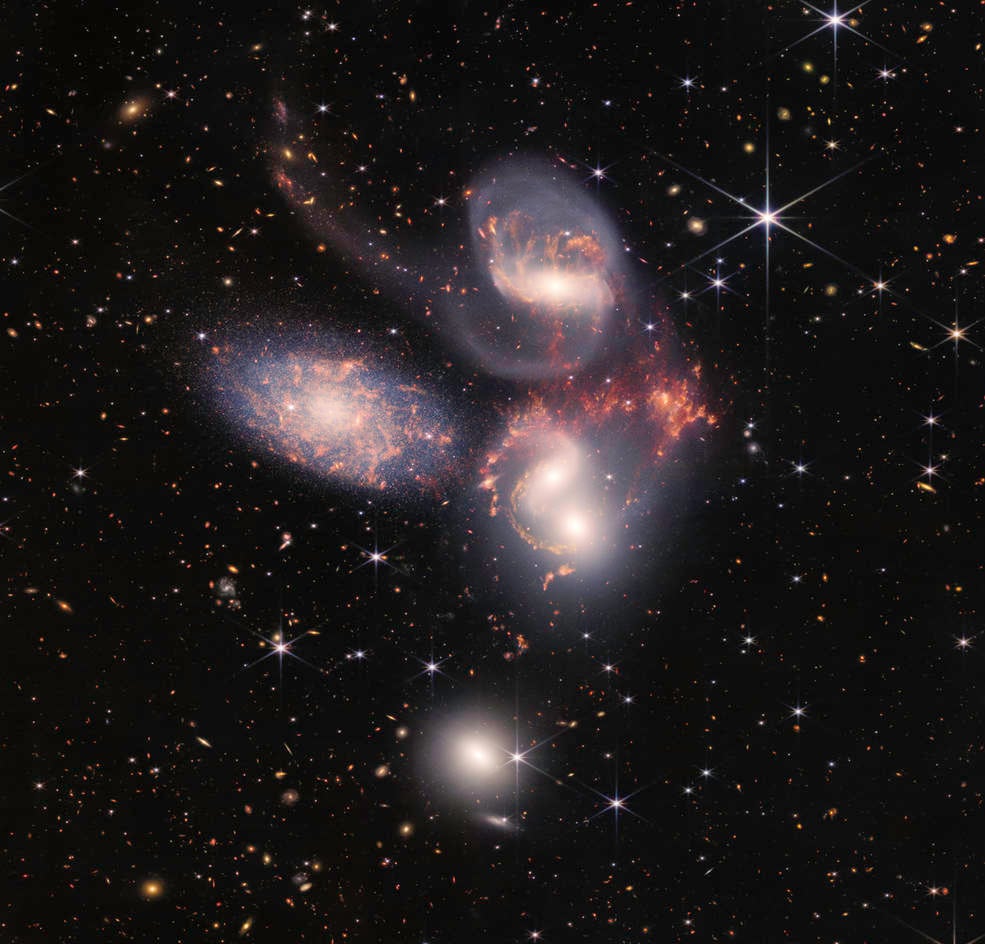
The James Webb Space Telescope’s image of the Stephan’s Quintet of galaxies. Courtesy of NASA, ESA, CSA, and STScI.
Translating the data from Webb to create the gorgeous images revealed by NASA is a science in and of itself.
“We’re basically translating light that we can’t see into light that we can see by applying color like red, green, and blue to the different filters from Webb,” Joe DePasquale, senior science visuals developer, said. “There is a lot of aesthetics that are involved in this, painstakingly going through and cleaning these images up with an attention to detail at the pixel level in every image.”
“When I’m working on the astronomical data, it is this sort of marriage between art and science,” science visuals developer Alyssa Pagan added. “When you’re choosing colors for the filters, you really are trying to show the different details and the processes that are happening in the astronomical images, but at the end of the day you want it to be very compelling, you want it to be very beautiful, because space is beautiful.”
The resulting images will be instrumental in helping unravel the mysteries of the universe, but are also works of art in their own right.
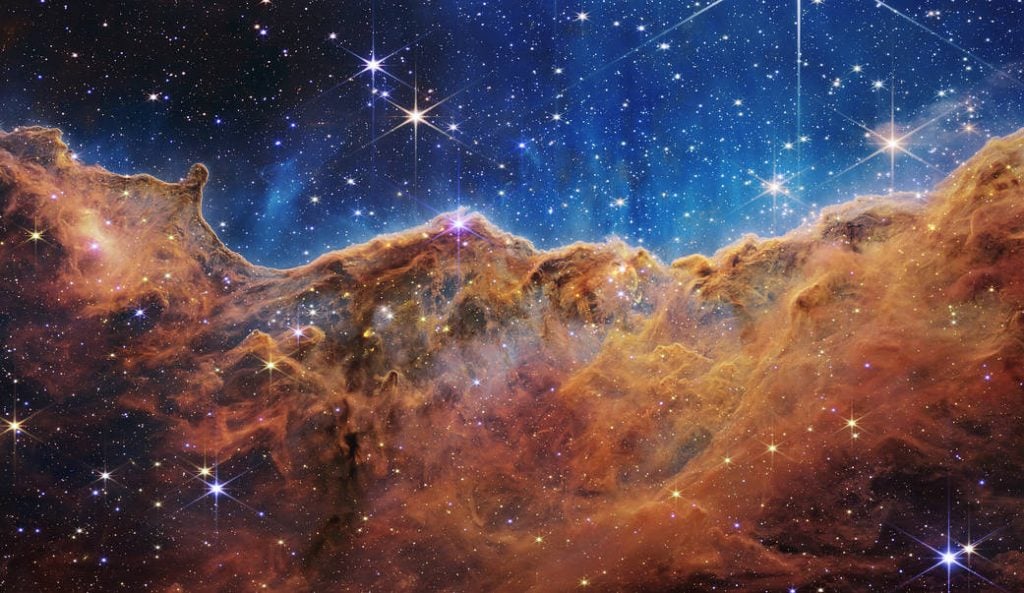
The James Webb Space Telescope’s image of the Carina Nebula. Courtesy of NASA, ESA, CSA, and STScI.
Astronomers wanted to train Webb on the Carina Nebula, 7,600 light-years from Earth, because it is a star-forming region, functioning as a stellar nursery filled with massive young hot stars.
The radiation from the nascent stars is eating away at the nebula wall, creating the “Cosmic Cliffs,” as astronomers have dubbed the edge of the gigantic, gaseous cavity captured in the image. What looks like steam rising from this mountain-like formation is hot, ionized gas and hot dust caused by ultraviolet radiation.
The Southern Ring Nebula, or the “Eight-Burst,” is an excellent example of the other end of a star’s lifespan. Some 2,000 light-years away from Earth, it shows the death throes of a dying star that has expelled a large part of its mass in waves, creating an expanding cloud of gas. There are actually two stars locked in orbit at the center of that nebula, the dimmer of which is cloaked in dust, a fact revealed for the first time by Webb.
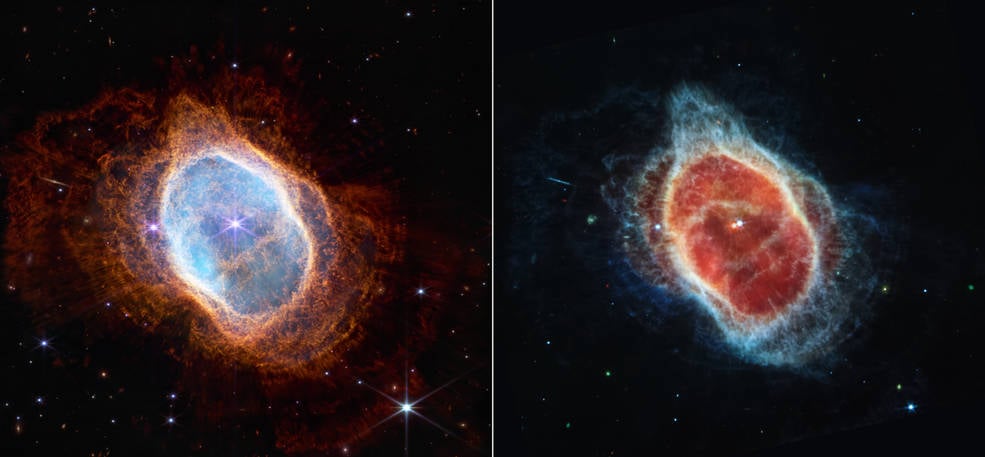
The Southern Ring Nebula, seen through the James Webb Space Telescope, at left in near-infrared light, and at right in mid-infrared light. Courtesy of NASA, ESA, CSA, and STScI.
Stephan’s Quintet (named after astronomer Édouard Stephan, who first observed it in 1877) shows galactic evolution on a larger scale. Here we see five galaxies seemingly on the verge of colliding, in a kind of cosmic dance fueled in part by a black hole. (Four are a compact group of galaxies about 290 million light-years away, while the fifth is actually about 40 million light-years from Earth.)
Webb used 1,000 individual shots to create a mosaic of the 150 megapixels view of the intergalatic region—its largest image of the initial batch of space photos, covering an area of the night sky equal to one fifth of the moon’s diameter, as seen from earth.
Galaxies collide in Stephan’s Quintet, pulling and stretching each other in a gravitational dance. In the mid-infrared view here, see how Webb pierces through dust, giving new insight into how interactions like these may have driven galaxy evolution in the early universe. pic.twitter.com/3P15LMCCOH
— NASA Webb Telescope (@NASAWebb) July 12, 2022
Webb’s observations of the distant exoplanet WASP-96b are based on changes in wavelengths of starlight as it passes through the atmosphere. Thanks to Webb, scientists now know there is water vapor there, and potentially clouds and haze in a steamy atmosphere. A gas giant half the mass of Jupiter, the planet is located 1,150 light-years from Earth and was discovered in 2014.
The WASP-96b image is the least visually interesting of Webb’s initial release. Nevertheless, it is this kind of work that could prove most groundbreaking for the telescope, helping guide the search for other potentially habitable planets and life outside Earth.
There are plans for more detailed observations of exoplanets by Webb in the coming months, starting with seven planets around the star Trappist-1, three of which may occupy the so-called “Goldilocks Zone,” being neither too hot nor too cold to support life.
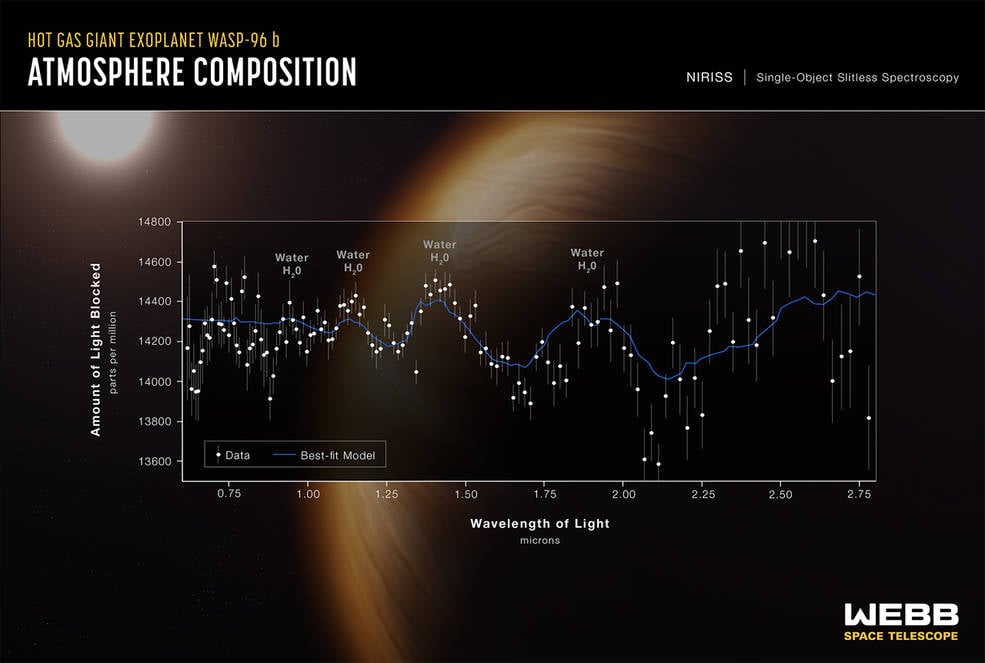
Observations of the distant exoplanet WASP-96b by the James Webb Space Telescope. Courtesy of NASA, ESA, CSA, and STScI.
Launched on Christmas Day, Webb undertook a 29-day journey of one million miles to L2, a Lagrange point where the intersection of gravitational fields allows it to stay in a constant orbit with minimal fuel or adjustments.
Before it could begin making observations, the telescope also had to successfully unfold and deploy both of its 21-foot gold-coated mirrors and its five-layer sunshield, which is the size of a tennis court.
The process entailed more than 300 steps, any one of which could have rendered the telescope inoperable if it failed. Unlike with the Hubble telescope, which is just 375 miles from Earth, a manned servicing operation of Webb is impossible.
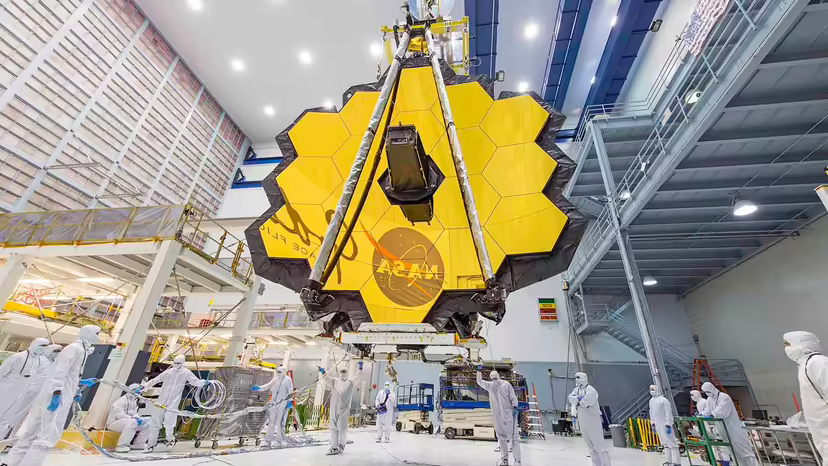
The James Webb Space Telescope’s optical telescope element, an 18-panel mirror, at NASA’s Goddard Space Flight Center in Greenbelt, Maryland, in 2017. Photo by Desiree Stover, courtesy of NASA.
But from its perch deep in space, Webb can view the stars unobstructed by the earth’s atmosphere, its 250,000 tiny shutters capturing images of the cosmos in stunning clarity. The telescope is designed to specialize in infrared observations, detecting light that is so far away that its wavelengths have “redshifted,” passing out of the visible spectrum.
In honor of the highly anticipated release of the images, today’s Google Doodle features the telescope, with Webb’s signature hexagonal-paneled gold-coated mirror and the Deep Field snapshot standing in for the “O’s” in the search engine logo.